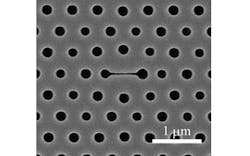| This image shows a top view of a photonic-crystal nanolaser biosensor, in which the center narrow slot (horizontal line) is the main part of the sensor. The size variation of the holes is intentional; the hole sizes are all optimized so that the laser's emission is effectively extracted to the top. (Credit: Toshihiko Baba/Yokohama National University) |
A photonic-crystal nanolaser biosensor developed by a group at Yokohama National University (Yokohama, Japan) detects the adsorption of biomolecules based on the laser's wavelength shift. The technology may lead to a low-cost and simple way to detect DNA and other biomolecules such as biomarker proteins of cancer or other diseases such as Alzheimer's.1
The gallium indium arsenide phosphide (GaInAsP) nanolaser biosensor also enables detection of the surface charge from its laser-emission intensity, which in turn can be used to sense the adsorption of biomolecules.
"In the beginning we focused on wavelength behavior, but quickly noticed that [the laser emission] intensity is influenced by both pH and polymers," says Toshihiko Baba, a professor in Yokohama National University's Department of Electrical and Computer Engineering. "Our results were very reproducible and, interestingly, we found that the behaviors of the wavelength and intensity are independent."
The nanolaser device can sense surface charge because the surface charge changes the occupancy rate of electrons at the surface states in the semiconductor of the nanolaser, as Baba explains. "This modifies the semiconductor's emission efficiency," he notes.
So far, the team's work is the first report of the detection of surface charges using such photonic sensors. "It enables detection of the adsorption of biomolecules from the nanolaser biosensor both in terms of wavelength and intensity," Baba says. Because it involves different physical parameters, the researchers can examine the details of the biomolecules.
It also enables detection of the adsorption by measuring only its intensity, which is a significant advantage compared to conventional methods, notes Baba.
No labels or spectrometry needed
One conventional biosensing method relies on fluorescent labels that are functionalized to biomolecules in advance, says Baba. "We can easily see the target biomolecules by using photoexcitation, which is the de-facto standard method used today in bioscience and medical diagnoses." The downside, unfortunately, is that the functionalization process of the fluorescent labels is expensive.
For this reason, many research groups have developed label-free methods such as those using resonance in optical cavities and plasmonic states. However, these require spectral analyses using spectroscopy of wavelength or resonance optical angle, which are also expensive.
By contrast, the team's nanolaser biosensor needs neither labels nor spectrometers if they use the intensity change. This greatly simplifies detection, which they have already demonstrated in the case of DNA.
REFERENCE:
1. Keisuke Watanabe et al., Applied Physics Letters (2015); http://dx.doi.org/10.1063/1.4904481
